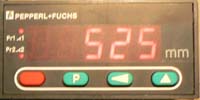

 Home
Back
Home
Back
Guide to counter SI8 Owen Dowmload Sive: 1.3 Mb
Fig. 1 Impulse counter DA-5 Pepperl + Fuchs

Fig.2 Pulse counter AS-8 Kracht

Fig.3 Pulse counter SI8 Owen
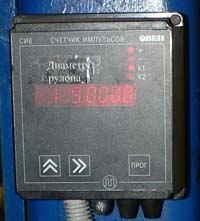
Fig.4 The real characteristic of the flowmeter
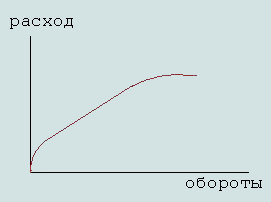
Fig.5 The simplest approximation of the characteristics of the flowmeter
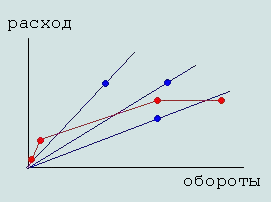
The protocol with the devices Owen Dowmload Size: 1285 kb Changed:30.06.2009
Secondary device counters (slave) connected to a serial cable twisted pair "with the wave impedance of 100 ohms. The cable is acceptable up to 1000 meters. At last the secondary device, you must install the terminator. Terminator is the usual resistance, its magnitude must be equal to the characteristic impedance of the cable (in this case 100 ohms). It is required for suppression of the secondary wave, which is reflected from the end of the line of communication, as well as for current feeding "twisted pair". Fig.6 Construction of the line RS-485 communication from the leadership of the AC3 Aries
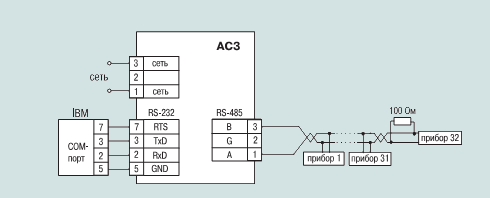
In RS-485 protocol Aries provides the presence of only one lead (master), usually a PC with a program survey of secondary devices. Counters SI8 serve as slaves (slaves), they can not themselves initiate the exchange of data and waiting for the command to request data from the lead. Upon receiving the command data request from a leading computer sends the requested data to the network RS-485. This computer does not check the free or busy line of communication and after about 1.1ms gives the answer. This is a shortcoming of the protocol OWEN, because it may cause conflicts in the communication line. In addition, if you use converter interface in which the transmit / receive data in a communication line is selected signal RTS (AC3 Aries), then there is always a chance not to have time to remove its activity within 1 ms, which leads to loss of integrity of the response from the counter. This is particularly sensitive to the OS XP / Vista where the suspension of your program can significantly exceed the interval of 1ms. Settings latency response in the counter SI8 not. To solve this problem, use the converters interface with automatic transmit / receive (AS3M Aries). I solved this problem with the AC3 closure signal TD to RTS jumper and does not use the RTS signal from the COM port of a PC. With such a connection AC3 begins to work as AS3M. Interestingly, the company has developed ARIES AS3M the same way or not?
Another feature of the protocol Aries (and probably its lack) is the transfer of bytes of information tetrad-character way. That is, each transferred byte is divided into two tetrads, each of which is assigned a predetermined symbol, these symbols are transmitted in a communication line. On the receiving side for receiving bytes of information necessary to properly glue these notebooks.
| tetrad | symbol | bytes of which pedalaetsya on line (character code) |
| 0000 | G | 47hex |
| 0001 | H | 48hex |
| 0010 | I | 49hex |
| 0011 | J | 4Ahex |
| 0100 | K | 4Bhex |
| 0101 | L | 4Chex |
| 0110 | M | 4Dhex |
| 0111 | N | 4Ehex |
| 1000 | O | 4Fhex |
| 1001 | P | 50hex |
| 1010 | Q | 51hex |
| 1011 | R | 52hex |
| 1100 | S | 53hex |
| 1101 | T | 54hex |
| 1110 | U | 55hex |
| 1111 | V | 56hex |
In addition to the character set for the transfer of tetrads are two marker parcels (frame).
This is a # (code 23hex) which serves to indicate the beginning of a parcel (frame) and the symbol CR (code 0Dhex) end of the parcel.
Fig.7 Structure of the frame protocol OWEN

| parameter name | hash-fold | tetrad symbol | description command |
| DCNT | C173hex | SHNJ | meter readings |
| DSPD | 8FC2hex | OVSI | reading flowmeter |
| DTMR | E69Chex | UMPS | readouts timer |
This shows that you can only read my meter, program the settings on the network can not.
For example to read the meter readings with Adr = 4, should be sent to the network the following premise:
# GKHGSHNJNPHU (CR) in hex format, 23 April 1910 C1 73 79 1E 0D
In response, we get (if you count the zeros) answer:
# GKGKSHNJGGGGGGGGBCD5 (CR) in hex format, April 23, 2004 C1 73 00 00 00 00 BC D5
Fig.8 algorithm for computing the checksum protocol OWEN one byte
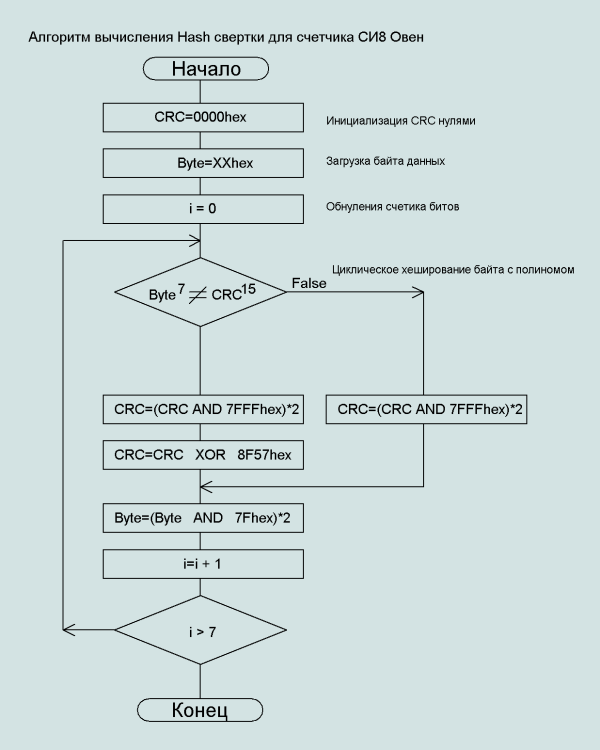
The question remains for hash-fold parameter name, describe in detail I did not will. OWEN designers here for some reason namudrili. The names of the parameters of the device are written clearly displayed in the ASCII transmission tetra-characters in the ASCII. Why convert ASCII to ASCII. For example the parameter names DCNT-> SHNJ, DSPD-> OVST, DTMR-> UMPS always displayed in the same. Aries offers to the parameter name in ASCII (eg DCNT), put it in dvoychny species is not on the code page to ASCII, and the code page invented OWEN. Then make a hash-convolution of a polynomial 8F57hex the algorithm somewhat different from that presented in Figure 8 and the resulting hash-convolution of the transfer in a notebook-symbols on the table Aries. What caused such a thought process of developers I can not explain, why did not immediately call options as needed to insert into the frame?
You may not use all of these changes to work with SI8, you only need to know what the parcel needs to be sent to each address unit.
It's easier to do manually on a sheet of paper than to write algorithms for all these treatments.
You can use the table 3, where the parcels are counted for the first 15 addresses.
| instrument address | format | запрос DCNT | request DSPD | request DTMR |
| 01 | hex | 0110C173A818 | 01108FC2D5F5 | 0110E69C92C6 |
|---|---|---|---|---|
| package | GHHGSHNJQOHO | GHHGOVSITLVL | GHHGUMPSPISM | |
| 02 | hex | 0210C173E71A | 02108FC29AF7 | 0210E69CDDC4 |
| package | GIHGSHNJUNHQ | GIHGOVSIPQVN | GIHGUMPSTTSK | |
| 03 | hex | 0310C173DDE4 | 03108FC2A009 | 0310E69CE73A |
| package | GJHGSHNJTTUK | GJHGOVSIQGGP | GJHGUMPSUNJQ | |
| 04 | hex | 0410C173791E | 04108FC204F3 | 0410E69C43C0 |
| package | GKHGSHNJNPHU | GKHGOVSIGKVJ | GKHGUMPSKJSG | |
| 05 | hex | 0510C17343E0 | 05108FC23E0D | 0510E69C793E |
| package | GLHGSHNJKJUG | GLHGOVSIJUGT | GLHGUMPSNPJU | |
| 06 | hex | 0610C1730CE2 | 06108FC2710F | 0610E69C363C |
| package | GMHGSHNJGSUI | GMHGOVSINHGV | GMHGUMPSJMJS | |
| 07 | hex | 0710C173361C | 07108FC24BF1 | 0710E69C0CC2 |
| package | GNHGSHNJJMHS | GNHGOVSIKRVH | GNHGUMPSGSSI | |
| 08 | hex | 0810C173CA41 | 08108FC2B7AC | 0810E69CF09F |
| package | GOHGSHNJSQKH | GOHGOVSIRNQS | GOHGUMPSVGPV | |
| 09 | hex | 0910C173F0BF | 09108FC28D52 | 0910E69CCA61 |
| package | GPHGSHNJVGRV | GPHGOVSIOTLI | GPHGUMPSSQMH | |
| 10 | hex | 0A10C173BFBD | 0A108FC2C250 | 0A10E69C8563 |
| package | GQHGSHNJRVRT | GQHGOVSISILG | GQHGUMPSOLMJ | |
| 11 | hex | 0B10C1738543 | 0B108FC2F8AE | 0B10E69CBF9D |
| package | GRHGSHNJOLKJ | GRHGOVSIVOQU | GRHGUMPSRVPT | |
| 12 | hex | 0C10C17321B9 | 0C108FC25C54 | 0C10E69C1B67 |
| package | GSHGSHNJIHRP | GSHGOVSILSLK | GSHGUMPSHRMN | |
| 13 | hex | 0D10C1731B47 | 0D108FC266AA | 0D10E69C2199 |
| package | GTHGSHNJHRKN | GTHGOVSIMMQQ | GTHGUMPSIHPP | |
| 14 | hex | 0E10C1735445 | 0E108FC229A8 | 0E10E69C6E9B |
| посылка | GUHGSHNJLKKL | GUHGOVSIIPQO | GUHGUMPSMUPR | |
| 15 | hex | 0F10C1736EBB | 0F108FC21356 | 0F10E69C5465 |
| package | GVHGSHNJMURR | GVHGOVSIGJLM | GVHGUMPSLKML |
After receiving a response from the counter in the data field will be his testimony in a symbolic form. Turn characters into binary tetrads per table 1. The resulting binary number to be transferred to the meter readings according to the data format defined by Owen.
For DCNT